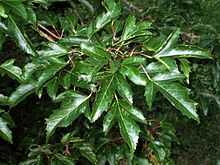Acer ginnala
| Acer ginnala | |
|---|---|
 | |
| Amur Maple foliage | |
| Scientific classification | |
| Kingdom: | Plantae |
| (unranked): | Angiosperms |
| (unranked): | Eudicots |
| (unranked): | Rosids |
| Order: | Sapindales |
| Family: | Sapindaceae[1] |
| Genus: | Acer |
| Species: | A. ginnala |
| Binomial name | |
| Acer ginnala Maxim. | |
Acer ginnala (Amur Maple) is a plant species with woody stems native to northeastern Asia from easternmost Mongolia east to Korea and Japan, and north to southeastern Siberia in the Amur River valley. It is a small Maple with deciduous leaves that is sometimes grown as a garden subject or boulevard tree.
Description
Acer ginnala is a deciduous spreading shrub or small tree growing to 3–10 m tall, with a short trunk up to 20–40 cm diameter and slender branches. The bark is thin, dull gray-brown, and smooth at first but becoming shallowly fissured on old plants. The leaves are opposite and simple, 4–10 cm long and 3-6 wide, deeply palmately lobed with three or five lobes, of which two small basal lobes (sometimes absent) and three larger apical lobes; the lobes are coarsely and irregularly toothed, and the upper leaf surface glossy. The leaves turn brilliant orange to red in autumn, and are on slender, often pink-tinged, petioles 3–5 cm long. The flowers are yellow-green, 5–8 mm diameter, produced in spreading panicles in spring as the leaves open. The fruit is a paired reddish samara, 8–10 mm long with a 1.5–2 cm wing, maturing in late summer to early autumn.[2]
Taxonomy
Amur Maple is closely related to Acer tataricum (Tatar Maple), and some botanists treat it as a subspecies A. tataricum subsp. ginnala (Maxim.) Wesm.) [3] They differ conspicuously in the glossy, deeply lobed leaves of A. ginnala, compared to the matte, unlobed or only shallowly lobed leaves of A. tataricum.[2]
Cultivation and uses
Acer ginnala is grown as an ornamental plant in northern regions of Europe and North America, where it is the most cold-tolerant maple, hardy to zone 2. It is naturalised in parts of North America.[4]
In the UK it has gained the Royal Horticultural Society's Award of Garden Merit.[5]
It is also valued in Japan and elsewhere as a species suitable for bonsai. It is a nonnative invasive species in parts of northern America.[6]
References
- ↑ Stevens, P. F. (2001 onwards). Angiosperm Phylogeny Website. Version 9, June 2008 [and more or less continuously updated since]. http://www.mobot.org/MOBOT/research/APweb/.
- ↑ 2.0 2.1 Rushforth, K. (1999). Trees of Britain and Europe. Collins ISBN 0-00-220013-9.
- ↑ Germplasm Resources Information Network: Acer tataricum subsp. ginnala
- ↑ USDA Plant Profile: Acer ginnala
- ↑ http://apps.rhs.org.uk/plantselector/plant?plantid=44
- ↑ Randall John The Encyclopedia of Intrusive Plants Brooklyn Botanic Garden, Janet Marinelli, Brooklyn Botanic
External links
| Wikimedia Commons has media related to Acer ginnala. |